How to Build a Remote Patient Monitoring App

Yes, you’re right. I too believe that Remote patient monitoring, or RPM, has immense potential to transform the traditional ways of providing healthcare services using modern technology platforms. Not only does it connect patients & doctors anytime, anywhere but also offers convenience, reduced healthcare costs, and better quality of service for both the parties.
Before moving into further details, let’s take a look at some market facts first –
- The global RPM market is projected to grow from USD 23.2bn in 2020 to USD 117.1bn by 2025; at a CAGR of 38.2% between 2020 and 2025.
- In 2019, North America accounted for the largest share of the RPM market, followed by Europe. North America is expected to continue dominating the market.
- The Asia Pacific market is projected to register the highest CAGR of 42.4% during the forecasted period (2020-2025).
- High growth in countries like India & China is attributable to increasing geriatric population & chronic illness, improving healthcare infrastructure, rapid economic growth and rising standards of living.
While the remote patient monitoring system was already gaining popularity, the advent of COVID-19 moved RPM technology from the healthcare “wish list” to the “priority list”.
The COVID-19 pandemic has had a devastating impact on the economic health of most countries, but it has provided immense opportunities for RPM solutions. The fear of this spreading virus discouraged many people from physically visiting hospitals, and hence using online means to get doctor consultation. Currently, more than 80% of hospitals across the United States are investing in RPM technologies for patients who are old, unstable, and at a higher risk of getting infected.
With the increased usage of RPM amidst the pandemic, there has also been a surge in the number of companies choosing to enter into mergers and acquisitions. Philips has recently agreed to acquire BioTelemetry, a medical technology company that specialises in cardiac diagnostics and RPM services. This deal will allow Philips to expand its RPM business and to dominate the market for the foreseeable future.
All the above factors only vouch for the increasing popularity of this technology and stresses upon the fact that it is here to stay!
- What is Remote Patient Monitoring and how is it different from Telehealth?
- What are the Benefits of Remote Health Monitoring?
- Types of Remote Patient Monitoring Apps
- Basic features of a RPM App
- How to make your app successful?
- RPM App Development Process
What is Remote Patient Monitoring and how is it different from Telehealth?
Wondering what Remote Patient Monitoring is? RPM is a system that allows healthcare providers to track health conditions of their patients remotely, i.e., outside the clinical setting, particularly essential for the management of chronic diseases.
Telehealth & RPM are often considered to be interchangeable terms, but they’re not the same. Telehealth is a broader term and RPM is only a subset of it. Telehealth extends to include the entire industry, methodology and technologies that facilitate interaction between clinicians and patients at home. This could be through videoconferencing, remote monitoring, electronic consultations or wireless communications. Telehealth helps to ensure that patients receive the right guidance at the place and at the right time by increasing access to doctors.
In this sense, remote health monitoring can be considered as a telehealth delivery system.
What are the Benefits of Remote Health Monitoring?
A question with many encouraging answers.
For Patients
1. Easy Access to Specialists
Many individuals, particularly the elderly who have chronic diseases, require frequent check-ups and need to be continually properly monitored. It is time-consuming for them to drive back and forth to visit physicians, and alternatives such as in-house care are unreasonably expensive for the majority of patients. There is also an increased risk of exposure to viruses, like corona, which can be fatal for the elderly. These factors can be easily negated by the adoption of remote patient monitoring. With patient home monitoring, patients can access their caregivers anytime, anywhere.
2. Enhanced Quality of Medical Care
Telehealth home monitoring improves both the quantity & quality of healthcare. It connects patients and medical practitioners virtually and provides real time updates of the patient’s health. Because doctors are able to monitor the real time condition of their patients, patients receive better quality of care, resulting in early detection of symptoms, shortened hospital stays, lesser hospitalisation expenditure. It also helps improve patient behaviour as they get more engaged and accountable for their own health, thus improving the overall health prospects in the long run.
3. Increased Patient Engagement & Satisfaction
From a psychological aspect, It is oddly satisfying to have an assurance that someone is always watching you and cares about your well being. This way patients also stay more alert & responsible for their health, by say, not skipping routine exercise or medication because their doctors will be notified.
4. Constant Support, Feedback and Education
Remote monitoring in healthcare opens up the space for effortless interaction between a doctor & patient. This way patients can potentially receive more education and feedback about their medical vitals compared to regular appointments.
For Healthcare Providers
1. Improvement in Acute and Chronic Condition Management
Chronic conditions account for 90% of healthcare costs in the United States, but many of them can be better managed with patient behaviors. With remote patient monitoring apps, doctors can better manage chronic conditions by receiving & analysing more of real time patient-generated data such as blood glucose in diabetes, blood pressure in hypertension, keeping track of patient’s physical activity, weight and medications taken. This offers care providers the opportunity to provide feedback and take immediate action, if required.
2. Reduction in Emergency Cases and Readmissions
Continuous surveillance through remote patient monitoring telehealth applications can even reduce the risk of emergency cases. More than 80% of total costs in the healthcare industry are incurred by emergency room visits and hospitalizations. These can be reduced by introducing RPM technology to patients with diseases like Blood Glucose so that they do not suffer sudden emergency situations like hypoglycemia.
3. Growth in Revenue Generation
RPM offers an increased revenue stream by allowing physicians to bill for services done remotely without having to bring patients in. 99453, 99454, 99457, and 99091 are some of the billing codes that allow reimbursement for time spent on activities in remote care, such as collecting & interpreting patient data or conducting interactive communication with the patient.
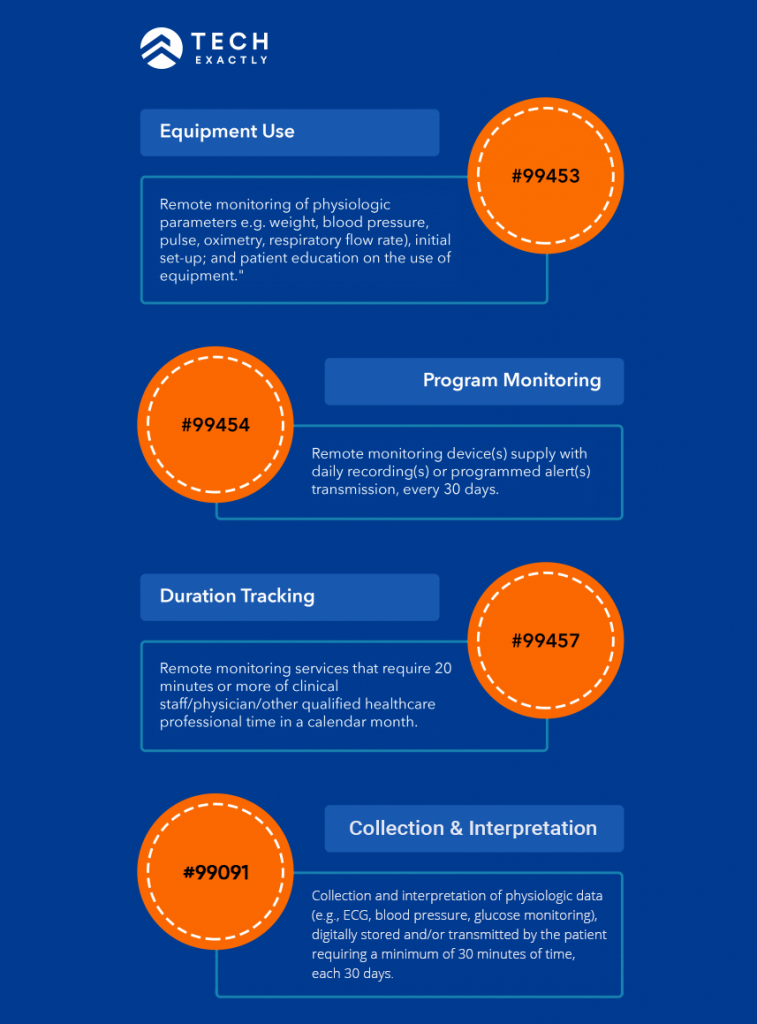
4. Smoother Workflow of the Healthcare System
With RPM, patients stay out of the clinic and do not wait in waiting rooms, don’t have to face delayed appointments, or delayed reports, and can avoid emergency hospital admissions. All these factors result in lesser burden on the healthcare systems and enable smoother workflow.
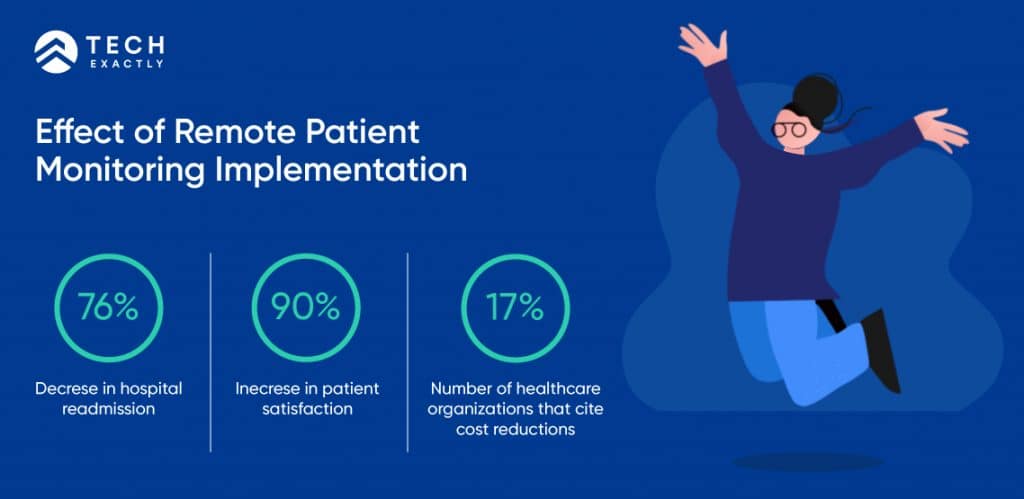
Types of Remote Patient Monitoring Apps
1. IoT Medical Applications
IOT health applications collect data from wearable devices through smart sensors, health trackers and send the information to the monitoring entities for proactive treatment. Alert mechanisms and reminders have a major impact on the growing popularity of these applications. For example Dexcom, Senseonics.
2. Questionnaire Apps
Collecting health related information through a series of questions is another popular and pivotal type of RPM Apps. It is less complicated than an IoT application and hence incurs less app development cost.
3. Video Conference Apps
These apps provide users with an option for video calls, making patient home monitoring much more practical & comfortable and help in strengthening the relationship between a patient and doctor. Some of the leading video conferencing apps are TrueConf, Teladoc.
4. Precise Medical Solution Apps
These apps collect anonymous patient health data solely for research purposes. With such apps, there’s no interaction between a doctor and patient. A classic example of such an app is the new health studies launched by Apple supported by its Apple watch series.
Basic Features of an RPM App
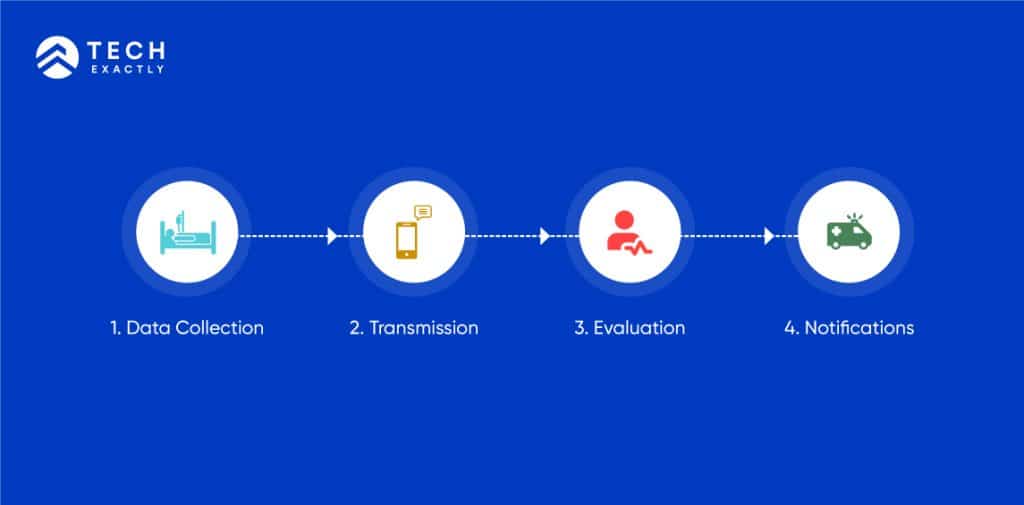
To build an app that improves patient outcomes and makes healthcare service cost effective, you must have the following features in your app.
1. Source Patient Data
The first and foremost step is to build a mechanism to collect real time patient health data, like, heart rate, blood pressure, body temperature, weight, height, activity data, as well as clinical records. Sourcing such data can be done with:
- HealthKit, ResearchKit, and CareKit for iOS apps
- GoogleFit for Android apps
- Using dedicated providers like Validic or Human API that share patient data via secure APIs.
- Using Bluetooth or Wi-Fi to pull vitals into the monitoring app directly from sensors or wearables.
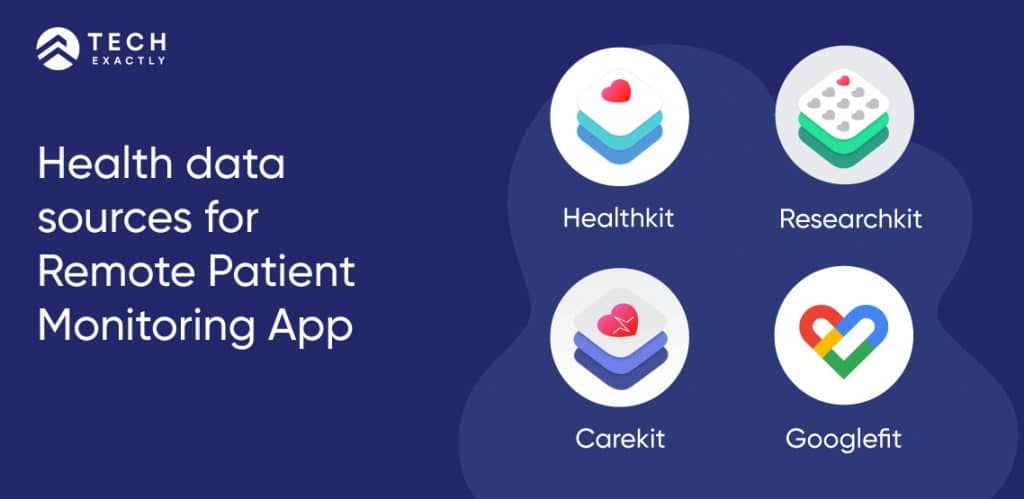
2. Data Integration with Doctor/ Hospital
The next obvious step is to securely transfer the collected patient data to the concerned doctor or hospital that will help them assess the advancement or deterioration of the patient’s health and suggest the next course of actions accordingly. This will need a secure API to connect to the EHR/EMR system of the hospital, adhering to the regulations at the same time.
Created by Health Level Seven International health-care standards organization, Fast Healthcare Interoperability Resource or FHIR is a standard for exchanging healthcare information that is fast gaining popularity among healthcare app telehealth monitoring system developers because it allows them to work with a modern tech stack.
3. Patient Engagement
A good RPM app should simultaneously engage patients by making their medical vitals visible to themselves, say, in the form of visuals like charts or graphs.
4. Doctor-Patient Interaction
Such communication setup can be done in the form of:
- secure video service (like Zoom, skype),
- 2-way messaging or real-time chat,
- audio calls
Irrespective of the medium of communication, there’s a need for end-to-end encryption and HIPAA, GDPR, and other regulatory compliances.
5. Notifications & Reminders
Implementing a ‘Notifications’ feature in your app will boost your user experience. Moreover, timely notification of a patient’s health status is very critical in RPM. For example, a notification about an upcoming appointment to both the patient & doctor.
Please note: HIPAA does not permit to include patient data in notifications.
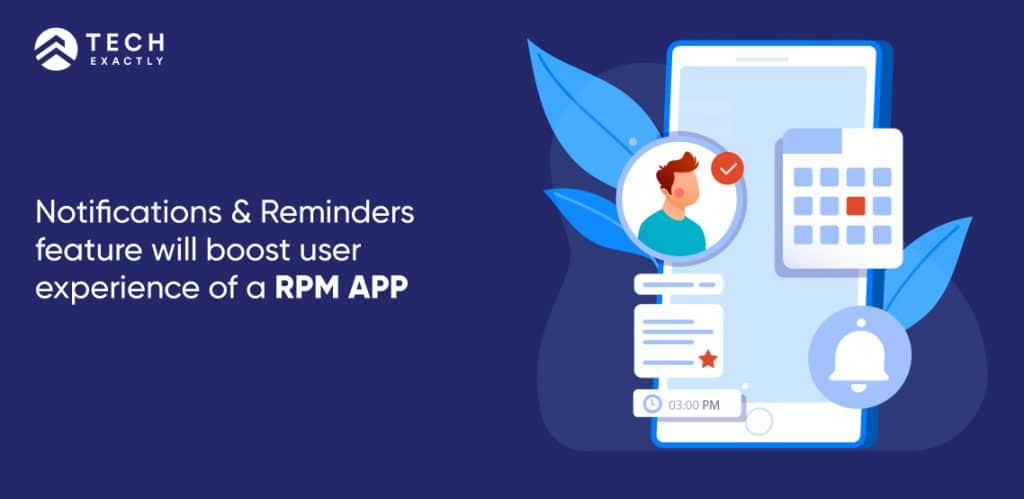
6. Payment Gateway
For convenience, a patient must have multiple & secure payment options at its disposal so that he/she can directly pay from the health app. In addition, both the users must be able to view payment history and past invoices for future reference.
How to make your app successful?
While there are many RPM apps available in the market, not each of them is successful. But don’t worry. We have listed out a few points below, implementing which will help you be on top of the game.
1. Patient Centric UX/UI
Not everyone is tech savvy. Ensure that the app has simple navigation options and keep the user interface as simple as you can. Remember, if your app is too complex, it will hinder user experience and ultimately result in failure of the app. Few tips:
- Simple UI with interactive features
- Avoid using jargon or providing unnecessary information.
- Use big touch screen options that are easy to click (comes in handy for elderly patients)
2. Comply with Security Guidelines
Integrating security systems in your health app is a must. HIPAA, HL7, FDA, IEC 62304, SOC2 Type2, and ISO27001 are some of the names that should be on your list when developing a RPM solution.
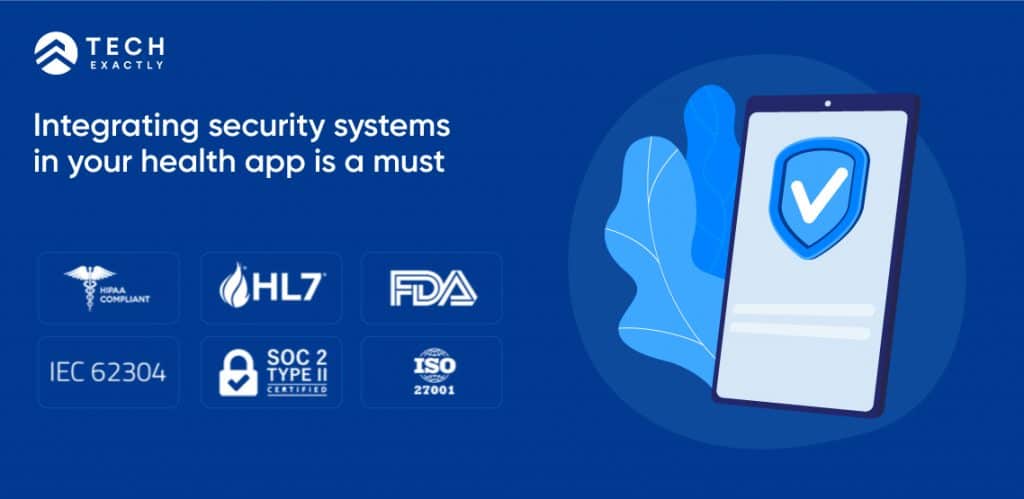
3. Analytics Module
Employ Business Intelligence tools and Data Visualization techniques in your app to show patterns and trends in patient’s health. With such analysis, doctors will be better able to predict risky events and make better informed treatment decisions.
4. Alternative for Internet Connectivity Issues
For saving all the data stored in your application when there is no internet, develop a caching mechanism which can automatically resync data back to the cloud once the internet is back. Tools like PIN Cache and NSURLCache for iOS, OkHttpClient for Android, or a platform like Firebase can support your caching mechanisms.
5. Battery Optimisation
In order to track health vitals continuously, your RPM software should be active all the time. Some tips to avoid battery drainage and decrease memory consumption are:
- Limiting background processes
- Enabling Bluetooth Low Energy (BLE) to connect to health trackers and wearables
- Using a dark mode when in the foreground for less energy consumption
- Notifying users when data collection or transmission is lost
6. Enabling Advanced Features
Having advanced features like Geo location or Voice commands will boost your user’s experience. With a location-aware home health monitoring app, users will be able to find the nearest clinic, or pharmacy, say in case of an emergency. Apple Maps or Google Maps are some tools that you can use.
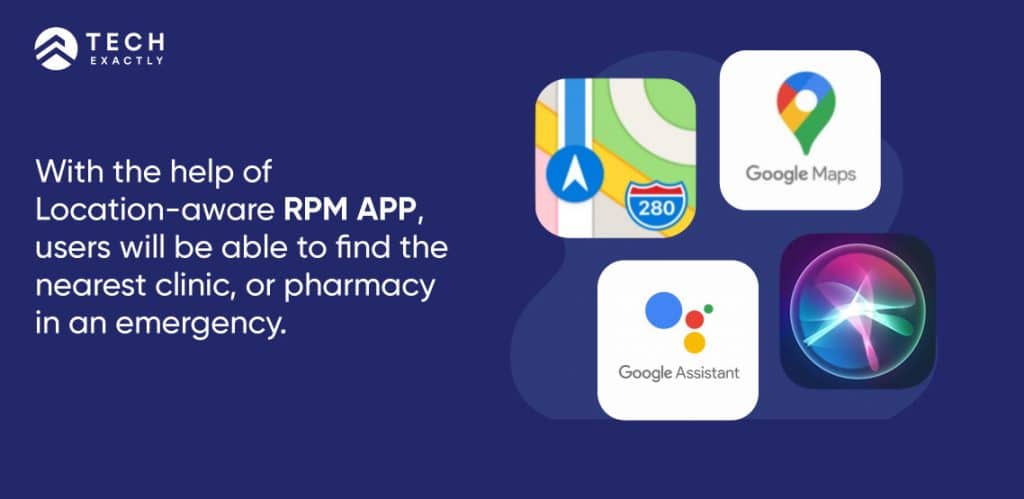
Similarly, the convenience of adding data to a RPM software with just a voice command will be appreciated by users, especially the elderly. You may use tools like Alexa, Siri, or Google Assistant to enable voice interface in your app.
Quick Tip: Take user’s confirmation (by repeating the command, either orally or in writing) before recording the voice command in the app’s database. This will help to avoid recording erroneous data.
7. Regular Updates
Only launching an app is not enough. You need to monitor the performance of the app, identify issues, troubleshoot them and ask for user feedback. Remember to subsequently add, remove or update features at regular intervals and update the change in regulations for a long term solution.
RPM App Development Process
Now, let’s throw some light on the app development process of such a carefully planned service:
Step 1: Start with Rapid Prototyping
Firstly, conduct a market research to identify your target audience. Now, because coding is expensive, it makes sense to first create a prototype for your product. Alternatively known as Minimum Viable Product (MVP), this method helps you build your product in iterations while keeping your overheads low. At the same time, you get user feedback early which helps you to better cater to the needs of your users.
Step 2: Develop Mobile App for Patients
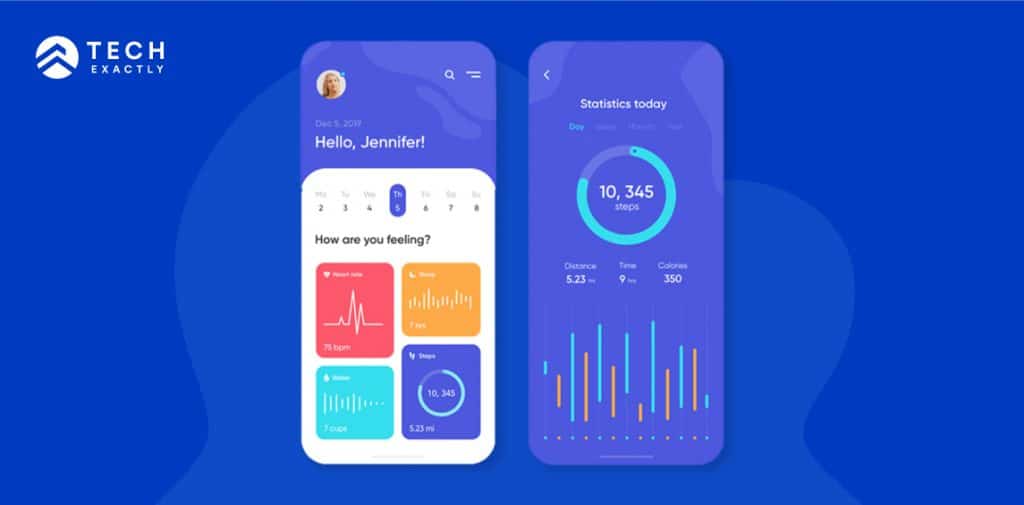
Today, close to two third of the world’s population own mobile phones, of which almost 80% use a smartphone. Interesting to note, global smartphone users increased by 40% in 2016-2020, and this growth is unstoppable. While smartphones are used almost everywhere outdoors, tablets are usually preferred for home use.
Hence, for smooth user experience, developers must make patient apps UX/UI friendly not only for smartphones but also for tablets. Also, there is a need for the app to be intuitive, interactive & have easy to use features.
Step 3: Develop Web App for the Care Team
Parallelly, you must build a web application for the health professional & team, because both the apps should be tightly in sync with each other.
Focus on crafting a healthcare web application which:
- is capable of storing patient health vitals required for proper treatment,
- plots patient’s readings in a graph or chart making it easier to track & analyze patient dynamics,
- gives notifications to doctors in situations like unusual readings,
- is intuitive & easy to navigate.
Step 4: Follow Compliances and Security Guidelines to a T
As a healthcare service provider, you have to adhere to all regulatory compliances applicable to your app, depending on your geographical or operational location. To name a few:
- HIPAA
- FDA
- IEC 62304
- SOC2 Type 2
- ISO27001
It will be wise to consider the following best practices while designing a remote health monitoring app:
- Encrypting health data whether at rest or moving.
- Establishing secure network connections (For example – HTTP)
- Implementing two factor authentication for an individual’s identity.
Step 5: Thoroughly Check and Test your App
Only developing a web & mobile app is not enough. It is important to identify and fix the bugs in your RPM Apps before deploying them to the app stores of different devices. The devices must also be properly tested for the accuracy of the data they receive and transmit.
Maintenance is an ongoing process to ensure your applications are safe, stable and free of bugs, breaches and crashes.
Also, after you have released your app, it is important to regularly update them, And after every update, or periodically, you must test run your processes, to ensure it’s working smoothly.
Last Thoughts…
Thanks to the rapid advancement in mobile technology & cloud computing, RPM is redefining the future of healthcare services. As digital technologies, like IoT, AI, and blockchain, continue to evolve, so will remote monitoring solutions.
People long believed that seeking medical attention was best done physically in front of a doctor. But with COVID-19 they’ve experienced the benefits of virtual care and are willing to do it again. In fact, two-thirds of Americans say that COVID-19 has increased their willingness to try telehealth in the future.
With this, all we can conclude is that the market for remote monitoring in healthcare is fast gaining momentum and is undoubtedly the next big thing in the healthcare industry.
Build your own Branded Remote Patient Monitoring System with us!
We, at Tech Exactly, deliver the best technological solutions for building healthcare service platforms. With extensive experience to strategize compliances for app & software development you can expect nothing but the best platform for your operations. Our expertise lies in:
- creating customized apps to suit your business requirements
- providing user-friendly apps catering to patients of all age groups
- being cost-effective in terms of app development
- using the latest & smart technology for your remote patient monitoring app development
- keeping compliance, security & safety as our #1 priority
